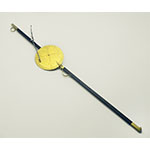Surveying instrument invented by the Nuremberg goldsmith Wentzel Jamnitzer in 1575. Consists of a graduated brass disk hinged off-center on a long wooden alidade with brass sights. The disk carries two graduated scales: the double shadow square, engraved along the upper half-circumference of the inner circle, and the degree scale (180°), engraved on the lower section of the outer circle. Two brass indexes (one now missing) marked the alidade’s inclination on the graduated scales during surveying work. A plumb level, now missing, enabled the user to keep the common diameter of the two circles vertical. This made it possible to determine the horizontal level of aqueducts and plots of land (with the alidade in horizontal position) and measure heights, distances, and depths (with the alidade tilted toward a distant point). During measurements, the alidade was blocked in the sighting position by means of the small steel clip placed on the back of the disk. Brought to Florence from Germany by Prince Mattias de' Medici in the first half of the seventeenth century.










